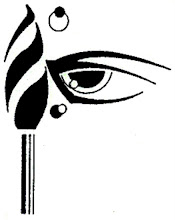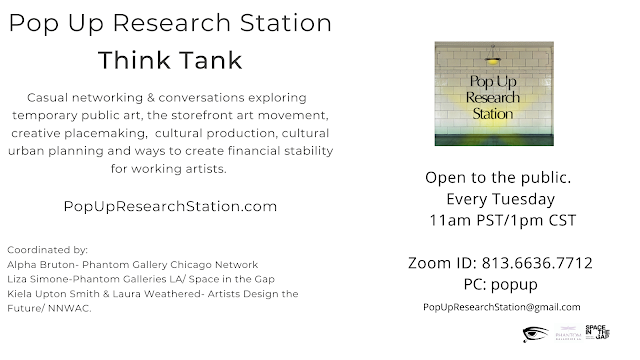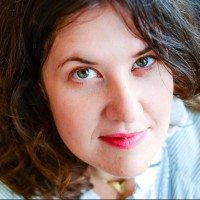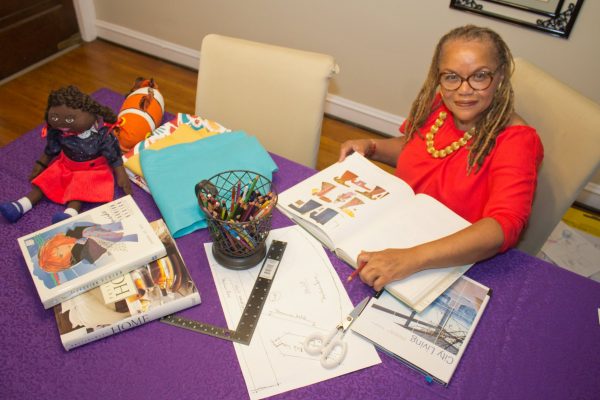The Phantom Galleries are temporary exhibitions in non traditional gallery settings.
STILL SEARCHING Art Exhibit - by Artist Damon Lamar Reed
 Alpha Bruton is the Chief Curator at Phantom Gallery Chicago Network, a project that connects artists with temporary installation spaces. She aims to examine the current changes in curatorial production and develop innovative displays concerning virtual spaces. "Curatorial Practice" explores the impact of the urban environment on the artist and their work and the contributions that artists make to the vitality of a city.
Alpha Bruton completed her studies in art education at California State University, Sacramento, and earned an MAAA in Art Administration from the School of the Art Institute of Chicago.
Alpha Bruton is the Chief Curator at Phantom Gallery Chicago Network, a project that connects artists with temporary installation spaces. She aims to examine the current changes in curatorial production and develop innovative displays concerning virtual spaces. "Curatorial Practice" explores the impact of the urban environment on the artist and their work and the contributions that artists make to the vitality of a city.
Alpha Bruton completed her studies in art education at California State University, Sacramento, and earned an MAAA in Art Administration from the School of the Art Institute of Chicago.
Archive and Legacy
The Internet Archive's Wayback Machine allows you to search for Web pages no longer accessible to the public. Browse by date through over 150 billion pages archived since 1996.
The Archive's mission is to help preserve digital artifacts and create a publicly accessible Internet library for researchers, historians, and scholars. The Archive collaborates with institutions, including the Library of Congress and the Smithsonian.It can take 6 to 24 months for pages to appear in the Wayback Machine after collecting them. The Archive does not collect pages that require a password to access, pages tagged for "robot exclusion" by their owners, pages that are only accessible when a person types into and sends a form, or pages on secure servers. If a site owner requests the removal of a Web site, that site will be excluded from the Wayback Machine.
Archives Collaboratives- the PopUp Research Station CAFÉ have collaborated with: Space in the Gap, Near North West Arts Council/Artists Design the Future, and the Phantom Gallery Chicago Network.
FY 2023 Grant Announcement: (Initial) Planning
The National Historical Publications and Records Commission (NHPRC) of the National Archives supports projects that promote access to America's historical records to encourage understanding of our democracy, history, and culture.
PopUp Research Station will be applying for the areas of documentary editing and publishing; archival preservation and processing of records for access; developing or updating descriptive systems; creation and development of archival and records management programs; development of standards, tools, and techniques to advance the work of archivists, records managers, and documentary editors; and promotion of the use of records by teachers, students, and the public.
 Alpha Bruton is the Chief Curator at Phantom Gallery Chicago Network, a project that connects artists with temporary installation spaces. She aims to examine the current changes in curatorial production and develop innovative displays concerning virtual spaces. "Curatorial Practice" explores the impact of the urban environment on the artist and their work and the contributions that artists make to the vitality of a city.
Alpha Bruton completed her studies in art education at California State University, Sacramento, and earned an MAAA in Art Administration from the School of the Art Institute of Chicago.
Alpha Bruton is the Chief Curator at Phantom Gallery Chicago Network, a project that connects artists with temporary installation spaces. She aims to examine the current changes in curatorial production and develop innovative displays concerning virtual spaces. "Curatorial Practice" explores the impact of the urban environment on the artist and their work and the contributions that artists make to the vitality of a city.
Alpha Bruton completed her studies in art education at California State University, Sacramento, and earned an MAAA in Art Administration from the School of the Art Institute of Chicago.
Pop-Up Research Station Weekly CAFÉ Zoom Meeting
 Alpha Bruton is the Chief Curator at Phantom Gallery Chicago Network, a project that connects artists with temporary installation spaces. She aims to examine the current changes in curatorial production and develop innovative displays concerning virtual spaces. "Curatorial Practice" explores the impact of the urban environment on the artist and their work and the contributions that artists make to the vitality of a city.
Alpha Bruton completed her studies in art education at California State University, Sacramento, and earned an MAAA in Art Administration from the School of the Art Institute of Chicago.
Alpha Bruton is the Chief Curator at Phantom Gallery Chicago Network, a project that connects artists with temporary installation spaces. She aims to examine the current changes in curatorial production and develop innovative displays concerning virtual spaces. "Curatorial Practice" explores the impact of the urban environment on the artist and their work and the contributions that artists make to the vitality of a city.
Alpha Bruton completed her studies in art education at California State University, Sacramento, and earned an MAAA in Art Administration from the School of the Art Institute of Chicago.
Effective Grant Writing for Emerging Artists
 Alpha Bruton is the Chief Curator at Phantom Gallery Chicago Network, a project that connects artists with temporary installation spaces. She aims to examine the current changes in curatorial production and develop innovative displays concerning virtual spaces. "Curatorial Practice" explores the impact of the urban environment on the artist and their work and the contributions that artists make to the vitality of a city.
Alpha Bruton completed her studies in art education at California State University, Sacramento, and earned an MAAA in Art Administration from the School of the Art Institute of Chicago.
Alpha Bruton is the Chief Curator at Phantom Gallery Chicago Network, a project that connects artists with temporary installation spaces. She aims to examine the current changes in curatorial production and develop innovative displays concerning virtual spaces. "Curatorial Practice" explores the impact of the urban environment on the artist and their work and the contributions that artists make to the vitality of a city.
Alpha Bruton completed her studies in art education at California State University, Sacramento, and earned an MAAA in Art Administration from the School of the Art Institute of Chicago.
From Bronzeville to Beverly: One Artist’s Black History Inspiration
 Alpha Bruton is the Chief Curator at Phantom Gallery Chicago Network, a project that connects artists with temporary installation spaces. She aims to examine the current changes in curatorial production and develop innovative displays concerning virtual spaces. "Curatorial Practice" explores the impact of the urban environment on the artist and their work and the contributions that artists make to the vitality of a city.
Alpha Bruton completed her studies in art education at California State University, Sacramento, and earned an MAAA in Art Administration from the School of the Art Institute of Chicago.
Alpha Bruton is the Chief Curator at Phantom Gallery Chicago Network, a project that connects artists with temporary installation spaces. She aims to examine the current changes in curatorial production and develop innovative displays concerning virtual spaces. "Curatorial Practice" explores the impact of the urban environment on the artist and their work and the contributions that artists make to the vitality of a city.
Alpha Bruton completed her studies in art education at California State University, Sacramento, and earned an MAAA in Art Administration from the School of the Art Institute of Chicago.
CALL FOR CURATORS! EVANSTON ART CENTER CURATORAL FELLOWSHIP
EVANSTON ART CENTER
Request for Proposals
CURATORIAL FELLOW
SECTION 1 – PROGRAM OVERVIEW & DESCRIPTION
Name of program:
Curatorial Fellow
Program Overview:
The Evanston Art Center (EAC), an artistic hub on the North Shore for over ninety years, believes some communities are too rarely represented in the curatorial world. To address this situation, the EAC is building a recurrent, project-based position for a curator who will work with the EAC to develop an exhibition of their choosing. The EAC is specifically seeking a Black, Indigenous, or Person of Color (BIPOC) curator with ties to communities of color in Evanston and the Chicago Metro-area to create an exhibition, along with related materials.
The curator will choose the exhibition's subject, theme, and content, with the EAC acting as a facilitator. It is the EAC’s intent that such an exhibit will build new ties to historically underrepresented groups and
introduce Evanston and the greater Chicago area to new curatorial and artistic perspectives.
Supporting Evanston Art Center’s Mission and Vision:
This program serves as an extension of the Evanston Art Center’s non-profit mission to foster the appreciation and expression of the arts among diverse audiences. It also fulfills its vision to be widely recognized as dynamic art education and exhibition center that encourages freedom of artistic expression and enriches cultural life. The EAC strives to be a hub of artistic endeavors, a passionate advocate for the arts, and a valuable partner for arts initiatives in the Evanston community.
SECTION 2 – SELECTION PROCESS OVERVIEW & EXHIBITION POLICIES
Jury Process:
The winning proposal will be selected by the Exhibition Committee of the EAC, a group comprised of board members and external colleagues and allies in the cultural sector, including artists, curators, art historians, collectors, and gallerists. In addition, a personal interview with some of the EAC Exhibition Committee members, President & CEO, and staff will take place for selected finalists.
Evaluation Criteria:
The Curator Identifies as BIPOC
The Curator has a Strong Connection to Evanston and Network Within BIPOC Communities in Evanston.
The Project Plans to Connect the EAC to Underserved Communities in Evanston and the Chicago metro area and Specifically BIPOC Communities.
The Project is Articulated Coherently and Clearly
The Project Presents New Perspectives
The Curator has Interesting and Recent Experience Presenting Contemporary Art.
Personal Interview
Communication Skills
Resume and references
EVANSTON ART CENTER
Request for Proposals
CURATORIAL FELLOW
Application Process:
All interested curators must submit the following materials for approval by EAC staff and its Exhibition Committee:
Exhibition Narrative (limit of 500 words):
What is your artistic vision / proposed plan for a curated exhibition at the Evanston Art Center?
The exhibition will be shown in the Main Gallery on the first floor of the Art Center at the end of the
curator’s fellowship for a period of roughly 6-8 weeks.
Public Programs (limit of 300 words):
How do you anticipate or wish to plan public programs or engage the Evanston Art Center community
in association with your curated exhibition? Please explain. The EAC is eager to support the creation
of public programs and welcomes the curator’s ideas, introductions, and networking assistance.
5-10 visual samples of curatorial work
All visual samples must be clearly labeled.
May include examples of the proposal.
Proposed needs for your exhibition
Resume / Curriculum Vitae
3 References
Application Deadline:
March 6, 2022
EAC will notify selected finalists the week of March 14, 2022.
Finalists will be interviewed by the week of March 21, 2022.
Curatorial Fellow will be selected by April 15, 2022.
Expectations and Limitations for the use of the Space:
Exhibition programming, lectures, and performances are all welcomed and encouraged along with other forms of public programming during the exhibition's run.
The curator is encouraged to propose workshops and/or educational offerings that can be enacted by the EAC staff.
The curator should plan to spend a reasonable amount of time at the EAC to ensure service to the whole
community.
All sculptures exhibited must be able to be moved by two people. As the Evanston Art Center hosts many rentals in the gallery space, sculptures that require more than two people to move must be placed on wheels or on a platform for the safety of the artwork.
All material presented must be suitable for all age groups.
Key Personnel:
Logistics: Cara Feeney, Evanston Art Center, Director of Exhibitions
Oversight: Paula Danoff, Evanston Art Center, Chief Executive Officer
Exhibition Committee Members
Exhibition Dates: July 8 – August 20, 2023
Floorplans & Photos:
https://www.dropbox.com/sh/yxv4o6kbyt1x0f5/AAAhM56D7d1PkiqTmFl9BmYTa?dl=0
EVANSTON ART CENTER
Request for Proposals
CURATORIAL FELLOW
SECTION 3 – CONTRACT
Curatorial Fee: $2,500 payable in full to the curator over 4 installments after quarterly updates to the Exhibition
Committee:
1st Installment: July 15, 2022
2nd Installment: October 14, 2022
3rd Installment: January 13, 2023
4th Installment: April 14, 2023
Exhibition Expenses: not more than $2,500 payable as reimbursements to the curator for documented expenses.
Curatorial Fellow will perform the following duties related to the development and implementation of this program:
Write thematic copy to be used in external marketing and the exhibition.
Assist with planning exhibition-related programming and participating artists and Evanston Art Center Staff.
Propose and assist in executing events or engagements with the community.
Provide an itemized budget for reimbursement.
Provide quarterly updates to the Exhibition Committee.
The Evanston Art Center exhibitions and education staff will:
Handle and oversee onsite logistics related to installation-site logistics for signage and lighting.
Provide on-site assistance to curators and artists' city requests and scheduling.
Support and participate in the curator’s public programming/education plans.
In collaboration with the curator, coordinate the design and printing of all exhibition marketing materials, including press releases, postcards, and brochures.
Proposals should be sent by MARCH 6, 2022, at Midnight to:
Cara Feeney, Director of Exhibitions: cfeeney@evanstonartcenter.org
 Alpha Bruton is the Chief Curator at Phantom Gallery Chicago Network, a project that connects artists with temporary installation spaces. She aims to examine the current changes in curatorial production and develop innovative displays concerning virtual spaces. "Curatorial Practice" explores the impact of the urban environment on the artist and their work and the contributions that artists make to the vitality of a city.
Alpha Bruton completed her studies in art education at California State University, Sacramento, and earned an MAAA in Art Administration from the School of the Art Institute of Chicago.
Alpha Bruton is the Chief Curator at Phantom Gallery Chicago Network, a project that connects artists with temporary installation spaces. She aims to examine the current changes in curatorial production and develop innovative displays concerning virtual spaces. "Curatorial Practice" explores the impact of the urban environment on the artist and their work and the contributions that artists make to the vitality of a city.
Alpha Bruton completed her studies in art education at California State University, Sacramento, and earned an MAAA in Art Administration from the School of the Art Institute of Chicago.
Organizing/Arranging Collection and Preparing it for Storage and Access
 Alpha Bruton is the Chief Curator at Phantom Gallery Chicago Network, a project that connects artists with temporary installation spaces. She aims to examine the current changes in curatorial production and develop innovative displays concerning virtual spaces. "Curatorial Practice" explores the impact of the urban environment on the artist and their work and the contributions that artists make to the vitality of a city.
Alpha Bruton completed her studies in art education at California State University, Sacramento, and earned an MAAA in Art Administration from the School of the Art Institute of Chicago.
Alpha Bruton is the Chief Curator at Phantom Gallery Chicago Network, a project that connects artists with temporary installation spaces. She aims to examine the current changes in curatorial production and develop innovative displays concerning virtual spaces. "Curatorial Practice" explores the impact of the urban environment on the artist and their work and the contributions that artists make to the vitality of a city.
Alpha Bruton completed her studies in art education at California State University, Sacramento, and earned an MAAA in Art Administration from the School of the Art Institute of Chicago.
Phantom Gallery CHI
Join us to celebrate the Overton Exchange POP! (Public Outdoor Plaza)!
"Art is Business" Creative Grounds: How might art, design, and architecture create a more inclusive and equitable repurposing p...

-
"Art is Business" —The ArtSlant Team ArtSlant shut down after twelve years of operation. Co-founder Catherine Ruggles has de...
-
"Art is Business" The opening reception is Friday, 16 September 2016, open studios and Bronzeville Summer Night Art District T...
-
"Art is Business" reposted for Talmadge - and Board and Members of Diaspora Rhythms Black Creativity Juried Art Exhibition 202...
-
Creative Conversation with Artist Itshanapa Dail Chambers 03/29 by Phantom Gallery Chicago Network | Visual Arts Podcasts : Sankofa: ...
-
"Art is Business" reposted for Dail Chambers The Convergence + Exhibitions After organizing with Yeyo Arts Collectiv...
-
"Art is Business" Renee' Baker's CHICAGO MODERN ORCHESTRA PROJECT/PEK CONTEMPORARY PROJECT Berlin present A PAGE OF...
-
"WH on Cottage" is a new GALLERY Located in the Woodlawn Community, at the POAH Woodlawn Resource Center. The new galler...




















